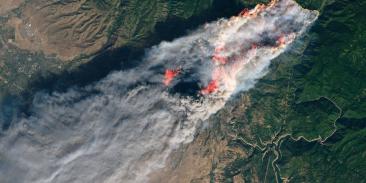Displaying 826 - 850 of 8894
-
Blog post
Does Oil & Gas Merger Boom Cast Doubt on Global Clean Energy Transition?
April 19, 2024 | Andrew Baxter, Senior Director, Business and Energy TransitionGovernments and regulators should recognize oil and gas mergers as an important inflexion point to ensure environmental harm is minimized and emissions are reduced.More on:
-
Press release
EDF Chief Scientist Steven Hamburg named AAAS Fellow for outstanding science research
April 19, 2024 | Steven Hamburg, Senior Vice President, Chief ScientistAAAS has honored EDF Chief Scientist Steven Hamburg with a prestigious fellowship for his outstanding science research, especially on climate change. -
Blog post
Empowering Chile’s Climate Action: A Citizen’s Guide to Article 6
April 18, 2024 | Luis Fernández Intriago, EconomistThis blog was authored by Francisco Pinto and Rodrigo Bórquez, economists of the Climate Action Teams (CAT) initiative, and by Environmental Defense Fund economist Luis Fernández Intriago. Source: Climate Action Teams Reducing emissions is imperative to address climate change. The mechanisms established in Article 6 of the Paris Agreement can serve as vital tools in …More on:
-
Blog post
Our Oceans Conference Reminds Us of the Ocean’s Incredible Value
April 18, 2024 | Kate Bonzon, Vice President, Climate Resilient Fisheries“An Ocean of Potential” was the tagline at this year’s Our Ocean conference in Greece on April 15-17. The phrase encompasses the breadth of possibilities that the ocean holds for us. It also encapsulates EDF’s approach to supporting climate-resilient fisheries and oceans. What do we mean when we say that there is “an ocean of …More on:
-
Press release
EPA’s Clean Car Standards are Legally Sound and Will Save Lives
April 18, 2024Statement of Alice Henderson, EDF Director and Lead Counsel for Transportation and Clean AirMore on:
-
Event
Climate Tech Convening Event
April 18, 2024At this installment of EDF's Climate Tech Convening series, we will moderate a discussion among farmers, research institutions, start-ups, agribusiness, anMore on:
-
Press release
New analysis shows reliance on gas is primary driver of rise in Duke Energy power bills
April 18, 2024 | Will Scott, Southeast Climate & Clean Energy DirectorIncreases in gas fuel costs account for 67% of residential retail rate increases since 2017 in parts of Duke Energy’s North Carolina territory — 46% in others.More on:
-
Issue Brief: The Role of Fuel Costs in Duke Energy’s North Carolina’s Retail Rates From 2017 Through March 2024
April 18, 2024 | Will Scott, Southeast Climate & Clean Energy DirectorThis Issue Brief illustrates the increasing role that fuel costs, principally natural gas costs, have played in electric rate increases on residential customers in the North Carolina service territories of Duke Energy Carolinas (DEC) and Duke Energy Progress (DEP) during recent years (2017-Q1 2024).More on:
-
Press release
EDF Chief Scientist Steven Hamburg named AAAS Fellow
April 18, 2024 | Steven Hamburg, Senior Vice President, Chief ScientistAAAS has honored EDF Chief Scientist Steven Hamburg with a fellowship -
Blog post
In the transition to electric, what about power resiliency?
April 18, 2024 | Dakoury Godo-Solo, Project Manager, Electric Vehicle Charging SystemsBy Dakoury Godo-Solo The adoption of electric trucks is on the rise, but as fleets make the transition, the idea of switching from diesel to electricity as a fuel source can raise concerns about reliability in the event of a power outage. Thankfully, this is a manageable challenge on the road to electrification — and …More on:
-
Article
Communities near natural gas facilities seek stronger protections
April 17, 2024The number of liquid natural gas export terminals along the Gulf Coast of Louisiana and Texas is growing. President Biden has issued a temporary pause on approvals for new facilities to better assess the risks they pose to climate and the health of local communities.More on:
-
Explainer
Why we’re concerned about BPA in food
April 17, 2024Bisphenol A, also known as BPA, is an industrial chemical that’s commonly used in household plastics and food packaging. BPA has been classified as an endocrine-disrupting chemical.More on:
-
Blog post
Multilateral Development Banks Must Turn Words into Action on Climate Finance
April 17, 2024 | Angela Churie Kallhauge, Executive Vice President, ImpactAddressing our planet’s climate crisis requires commitment, cooperation, and urgency – all underpinned by finance. But our international financial systems were not designed for a challenge of this scale, and we are falling behind in meeting the needs of developing countries in combatting climate change.More on:
-
Blog post
Unveiling Environmental Heroes: Environmental Defense Fund’s Climate Corps 2024 Program
April 16, 2024EDF's 2024 Climate Corps fellowship program empowers a new cohort of 185+ global fellows to advance climate solutions at over 130 organizations.More on:
-
Blog post
Strong scientific foundations, as well as strong science-based markets, make successful nature-based climate solutions possible
April 16, 2024 | Brian Buma, Senior Climate ScientistWe need nature-based climate solutons to work. Yet as a recent study shows, questions remain on how we can achieve the best ground-level outcomes and maximize the enormous potential of these solutions to lower greenhouse gas concentrations.More on:
-
Blog post
Supercharged strategies to fast-track electric fleet interconnection
April 16, 2024By Kae Tuitt As more and more companies transition to zero-emission medium- and heavy-duty electric vehicles, it is increasingly clear that the future is electric. Still, some fleet owners coordinating receipt of new electric trucks and buses may face challenges with delays arising from the potentially lengthy and opaque interconnection process of getting EV chargers …More on:
-
Press release
Experts: New threats to New Mexico’s rivers also endanger its groundwater resources
April 16, 2024 | Maurice Hall, Senior Advisor, Climate Resilient Water SystemsNew Mexico’s rivers are under severe threat, further endangering already strained ecosystems, drinking water sources and livelihoods across the state, accoMore on:
-
Article
Seaweed and mussels team up to transform a Philippine community
April 15, 2024A community in the Philippines is exploring the major benefits of seaweed farming.More on:
-
Report
Natural gas gathering pipelines: Mapping regulatory schemes and analyzing safety data
April 15, 2024This EDF report presents a mapping analysis that shows representations of several gas gathering pipeline systems in the United States and their federal “Class Location” categorizations. It also presents an overview of reported data on gathering pipelines, including recent safety incidents and their costs.More on:
-
Analysis
Improving household and community disaster recovery: Evidence on the role of insurance
April 15, 2024 | Carolyn Kousky, Associate Vice President, Economics and Policy AnalysisStudy shows that households with insurance are less likely to report high financial burdens in both the short and long term, and they are less likely to have unmet funding needs.More on:
-
Analysis
Building a cleaner, more resilient energy system in Cuba: Opportunities and challenges
April 14, 2024 | Daniel Whittle, Associate Vice President, Resilient CaribbeanCuba is in the midst of an economic and energy crisis, but with domestic action and international support, there is opportunity for change. This report by EDF and the Columbia Sabin Center for Climate Change Law presents the current context and recommendations for improvements over the short, medium and long-term.More on:
-
Blog post
We need to close a mercury pollution loophole for lignite coal plants
April 12, 2024(This post was co-authored by EDF attorney Richard Yates) The Environmental Protection Agency is soon expected to update our national protections against mercury and other toxic pollution from coal-fired power plants – pollution that is extremely dangerous to human health and has been linked to brain damage in children. EPA proposed strengthening the Mercury and …More on:
-
Press release
EDF to Vigorously Oppose New Effort to Block Oil and Gas Methane Protections in Court
April 12, 2024 | Rosalie Winn, Director and Lead Counsel, Methane and Clean Air PolicyStatement of Rosalie Winn, EDF Director and Lead Counsel for Methane and Clean Air PolicyMore on:
-
Blog post
How public-private partnerships can improve water sustainability
April 12, 2024The scale of the global freshwater crisis requires an all hands effort. Fostering diverse, sometimes difficult, partnerships — particularly between policymakers, producers, and frontline communities — is at the heart of EDF’s water program. Partnership is also at the center of an intriguing new book from Stanford law and environmental social sciences professor Barton “Buzz” …More on:
-
Blog post
FDA Says We Are All Made of Chemicals So How Can Any Be Bad For You?
April 11, 2024 | Maria Doa, Senior Director, Chemicals PolicyBy Maria Doa, PhD, Senior Director, Chemicals Policy, Maricel Maffini, PhD, Consultant, and Liora Fiksel, Project Manager, Healthy Communities What happened You may have seen news or online content from FDA about chemicals in our foods, including that our food – and everything else in the world – is made up of chemicals. FDA’s …More on:















